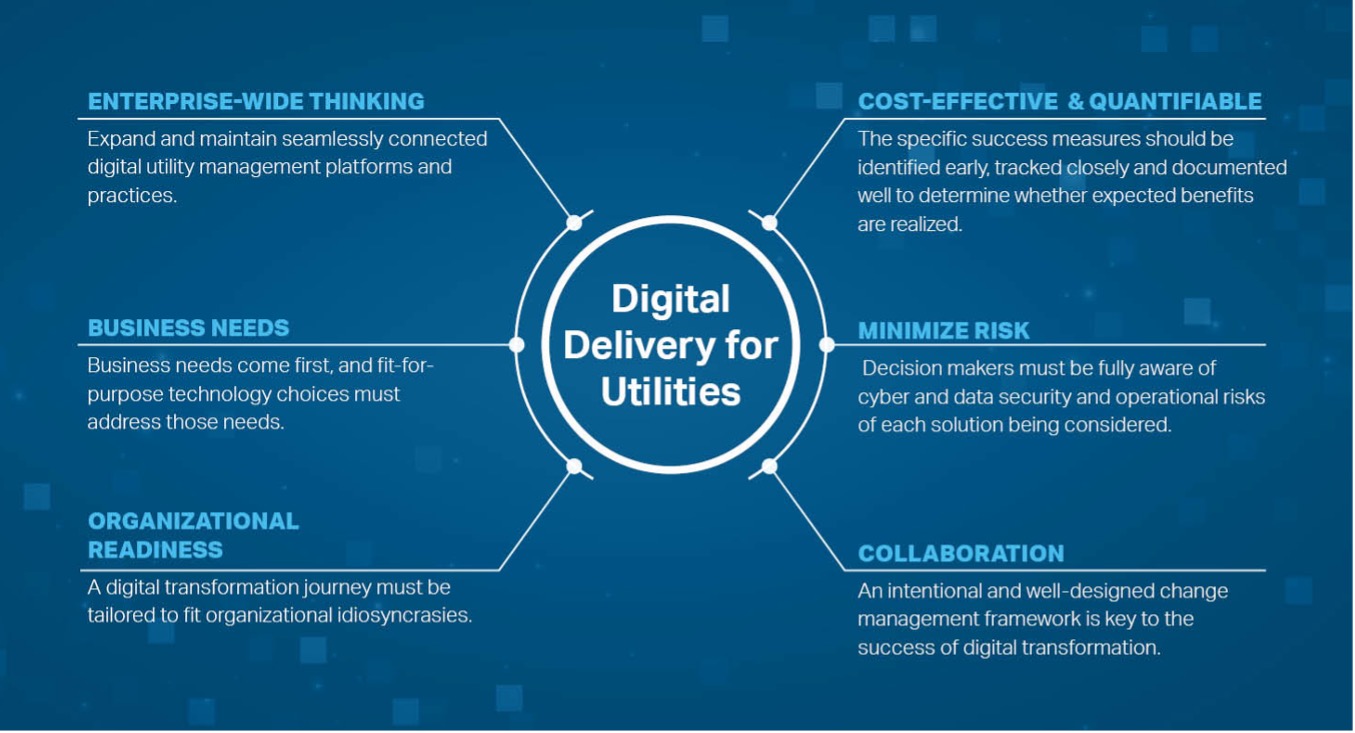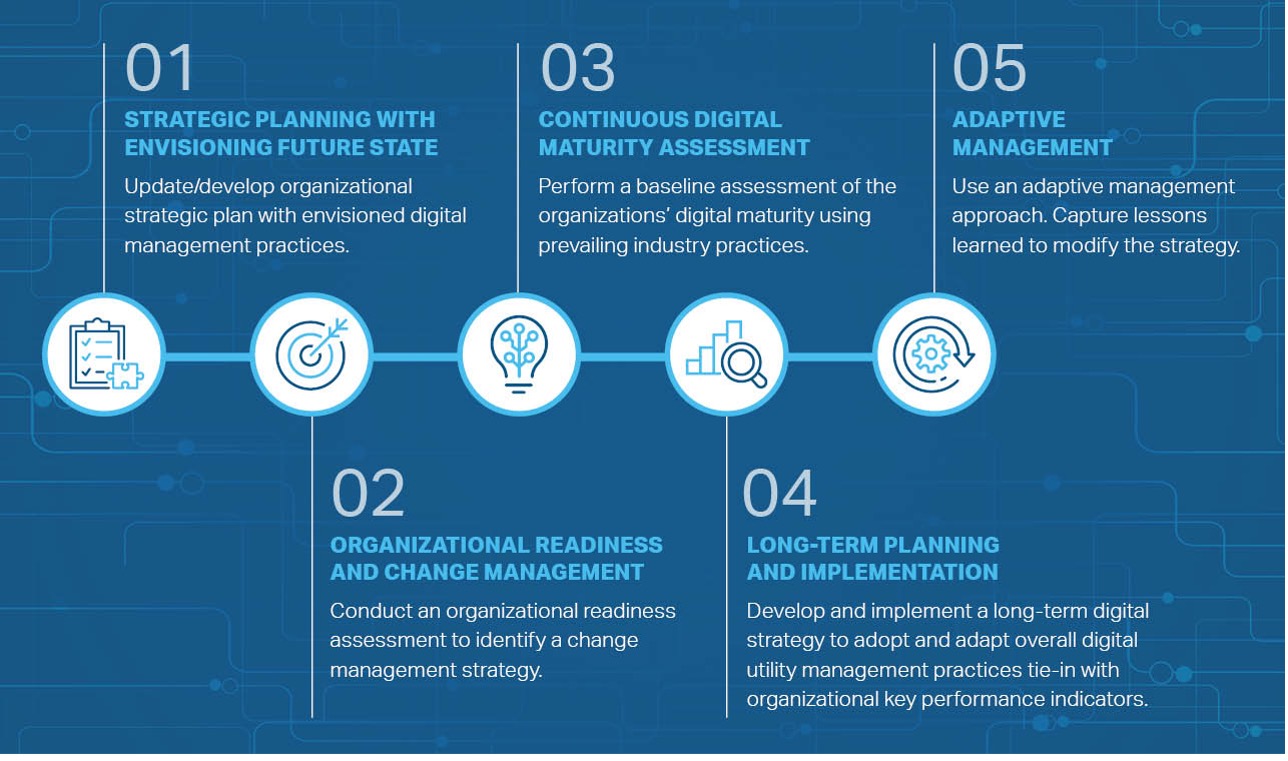Water utility leaders are continually improving asset management practices to deliver affordable services while facing dynamic water industry challenges. They are consistently tasked with delivering with fewer resources while adapting to changing regulatory environments, meeting customer service levels, and changing climate and workforce challenges. The financial and human resources to accomplish competing business needs are paramount.
Digital Opportunities and Barriers
Digital utility management practices are growing at a rapid pace to help with stated challenges. Enhanced digital solutions, such as sensorization; various data systems, big data analytics and intelligent platforms, are evolving at scale augmenting intelligence to a shifting workforce.
The continuous evolution of enterprise-wide integrated human and augmented/artificial intelligence is driving the future operations of water utilities. Utilities are poised for digital transformation at a faster rate with the adoption of digital solutions and intelligent water frameworks.
Actual pace of transformation widely varies based on individual utility circumstances. Barriers to coherent transformation of digital utility management practices occur when:
- Discrete digital solutions deployed over decades are disjointed and challenging to integrate and scale.
- Lack of enterprise-wide thinking has contributed to adoption gaps.
- Data and cyber security concerns and operational risks are not robustly addressed.
- Employees are skeptical and untrusting of any new processes and tools.
- The technologies adopted are not fit for purpose.

Guiding Principles
The following six guiding principles should help continually transform utility management for the digital age:
- Apply enterprise-wide (system) thinking to develop, expand and maintain seamlessly connected digital utility management platforms and practices.
- Digital strategy and solution adoption should be based primarily on business needs — what do the utility stakeholders need to accomplish — and not on preconceived technology choices. Business needs come first, and fit-for-purpose technology choices must address those needs.
- Water utilities should be self-aware of organizational readiness and maturity for increased levels of adoption and adaptation of relevant digital strategies and practices. A digital transformation journey must be tailored to fit organizational idiosyncrasies.
- Digital solutions and practices should lead to cost-effective and demonstrable business outcomes. Start simple and then move toward more complex measures. Use a phased and flexible approach. Build incrementally using experiences gained and implement systems that are easy to manage/upgrade/scale. The specific success measures should be identified early, tracked closely and documented well to determine whether expected benefits are realized.
- Digital solutions with increased use of integrated data systems and automation methods should minimize utility management risk. Decision makers must be fully aware of cyber and data security and operational risks of each solution being considered. Utilities should be open to modify or discontinue certain practices to minimize the multitude of risk factors including system performance failures. Likewise, they should be open to an acceptable level of failure as they navigate their digital journey and integrate various degrees of augmented and artificial intelligence.
- The success of implementing digital solutions depends on stakeholder ownership and collaboration from inception through implementation. An intentional and well-designed change management framework is key to the success of digital transformation. A structured process should be in place for achieving system acceptance by users. Digital adoption increases with growing stakeholder’s trust level as they realize promised benefits.

Roadmap
Every digital transformation journey is unique. Here are five key attributes to consider for establishing a roadmap:
- Strategic Planning with Envisioning Future State – Update/develop organizational strategic plan with envisioned digital management practices. Focus on people, processes and fit-for-purpose technologies while progressively building trust with key stakeholders.
- Organizational Readiness and Change Management – Conduct an organizational readiness assessment to identify a change management strategy. Develop and implement a well-designed and intentional change management process for realizing desired digital transformation journey. This will continually promote adoption of integrated enterprise-wide digital solutions.
- Continuous Digital Maturity Assessment – Perform a baseline assessment of the organization’s digital maturity using prevailing industry practices. This process allows updating and innovating the organization’s digital ecosystem towards a desired future state – with consideration to data, cyber and operational risk management.
- Long-Term Planning and Implementation – Develop and implement a long-term digital strategy to adopt and adapt overall digital utility management practices tie-in with organizational key performance indicators. Establish interim milestones. Implement the plan and continuously assess efficacy of the transformation journey.
- Adaptive Management – Use an adaptive management approach. Capture lessons learned to modify the strategy and subsequent implementation efforts. Adjust through updates to strategic planning; periodic maturity assessments; refinements to change management approaches; and updates to implementation techniques with further technology innovations.
Conclusion
For many water utilities, digital transformation represents disruption, a challenge to the status-quo, and a potential threat to long-established ways of working. Continually maturing digital utility management practices are necessary to address current and future water industry challenges. To get the most of new ways of working, organizations need to think hard about skills, organizational structures and procedures, and technology infrastructure. The guiding principles and the road map provided in this article are informed by real digital transformation journeys. The way forward is already paved. It’s time to embrace the path to water utilities of the future.